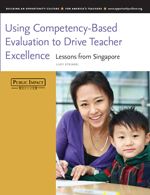 Lessons from Singapore
Lessons from Singapore
Many of Singapore’s lower-achieving students are learning at levels higher than gifted-student curricula in U.S. schools. What is the secret to Singapore’s success?
The complete recipe for Singapore’s educational success is not public, but one element stands out: the development and thorough use of performance-linked “competencies” to measure, reward, and develop teacher performance. This report, written with support from The Joyce Foundation, explores Singapore’s successful teacher evaluation and development system—recognized by its education leadership and teachers as effective and fair.
In the United States, reforms to teacher pay, career advancement, professional development, retention, and other human capital systems that lead to better student outcomes depend on fairly and accurately measuring teacher effectiveness. Where can the U.S. find the best-practice know-how for this? To start, it should look to nations that have revamped teacher performance measurement to sustain teaching excellence, and Singapore offers a remarkable example.
In the early 2000s, the small but racially and economically diverse nation of Singapore designed and implemented a new, performance-linked method of measuring teacher effectiveness that enables the evaluation of teachers in all subjects and grades. Singapore had already developed a high-performing education system. But as global economic opportunities for its citizens increased, it needed to ensure continued recruitment, retention, and performance of talented teachers. Today, Singapore’s students consistently perform at the top of internationally comparable exams, and 98 percent of Singapore’s sixth-grade students achieve math standards more rigorous than the eighth-grade standards on the U.S. NAEP exam (National Assessment of Educational Progress). Think of it this way: many of Singapore’s lower-achieving students are learning at levels higher than gifted-student curricula in U.S. schools. Singapore, while much smaller than the United States, compares in size to some of our states and largest cities, not one of which is on a path to achieve for children what Singapore has.
What can we learn from Singapore? Much, it seems, and Singapore knows it. Determining the ingredients in its “secret sauce” is a challenge. But we know that one critical element is Singapore’s development and thorough use of performance-linked “competencies” for all teachers. Education leaders take note: we’re not even close in the U.S., and yet similar systems and accompanying practices are within reach of any motivated leader who wants to achieve and sustain results like Singapore’s. This report provides a launching point. Here we present a brief background on the state of teacher evaluation in the United States, the case for why we can learn much from Singapore, and key facts about Singapore’s competency-based teacher evaluation system.
